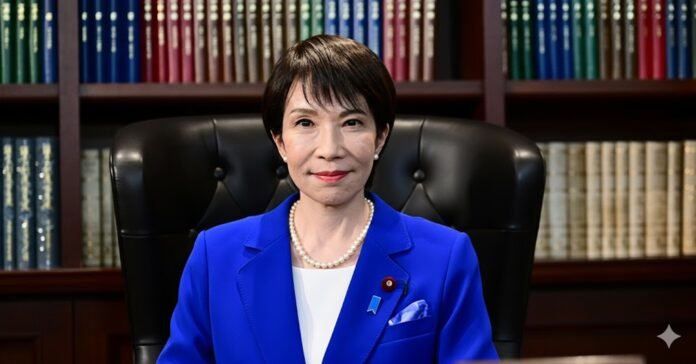TOKYO, Japan: This week, Japan’s highest political office got a new glass ceiling. Japan’s parliament, the Diet, has officially appointed Sanae Takaichi as the country’s first female prime minister. The ultraconservative politician attained the highest political office after a three-month political vacuum vested political power, primarily held by the Liberal Democratic Party (LDP) which suffered a shocking loss in elections in July.
Takaichi’s new position is historic for Japan. Still, she has the difficult task of balancing fragile political dynamics while trying to move a stagnant nation. Shigeru Ishiba, her predecessor, resigned earlier in the day though Takaichi had yet to take office and her political establishment was under fire.
The powerful lower house which by law has to pick the Prime Minister, awarded Takaichi 237 votes the majority of which surpasses to 4, unto her primary competitor, Yoshikoko Noda, of the largest opposition group, the Constitution Democratic Party of Japan, with 149. Takaichi is a former protégé of the late Prime Minister Shinzo Abe. The formal political culture of Japan demands a bow to acknowledge the moment. This is what Takaichi, as the results were read, was most noting.
Even If It’s Groundbreaking, It’s Not Feminist
Even though there are still places in Japan where men hold the most positions of power, Takiuchi’s rise is still something special. However, the history she made is not so special. Takaichi is an open admirer of British Prime Minister Margaret Thatcher, a woman, and has not supported the case for gender equality and the inclusion of all social divisions in Japan.
A clearer view of her political position shows a deeply conservative and somewhat predictable view that does not match the symbolic representation of her election as Japan First Female PM. She holds the position that the imperial family and the succession of power should remain male-only, is against same-sex marriage, and is against the idea of a married couple’s surname remaining separate, all of which are viewed by a major part of society as steps for women’s rights and Japan’s social progress.
Takaichi claimed that she would boost the number of women in the Cabinet and, going against that, she appointed only two women: Satsuki Katayama as finance minister and Kimi Onoda as economic security minister.
For supporters of diversity, this is a moment of mixed feelings. “Having the Japan First Female PM is historic, but [Takaichi] puts a negative mark on gender equity and rights of sexual minorities,” observed Soshi Matsuoka, a leading activist of the LGBTQ+ community. Matsuoka was ponderous on the issue: “For a female prime minister, Takaichi has very backward thinking on gender and sexuality, which might set dangerous precedents, especially for sexual minorities, on the rights issue.”
For a certain segment of the populace, merely breaking a political glass ceiling represents a significant shift. Takayuki Eguchi, a 62-year-old resident of Tokyo, captured the national mood of anxious anticipation. He was skeptical a woman would ever secure the necessary votes, and, in the meantime, he celebrated Takaichi’s achievement with a special edition of the newspaper. He wished her victory would provide a much-needed boost to the political scene, which has been dormant for far too long.
“I really hope she serves for a long time, and that the political stagnation we’ve been seeing finally starts to move, and that things improve in Japan and in the eyes of the world,” Eguchi said, voicing the expectation that her tenure will mark a significant turning point for the nation led by the Japan First Female PM.
The Fragility of a Coalition and Its Inherent Challenges
Takaichi did not secure a dominant mandate in which she won the majority of votes, but she did gain the premiership through a political maneuver at the last moment. In the week ahead of the election, the LDP, which has been suffering from political scandals, electoral defeats, and overall poor coalition partner relations, made a coalition agreement with the Osaka-based right-wing Japan Innovation Party (or Ishin no Kai). Having been abandoned by the Komeito and the LDP coalition which has long been a partner, Takaichi was able to win the election for the LDP against a divided, un-united opposition.
Despite the cooperation, Takaichi’s new alliance remains in a structural position of weakness, as they still do not have a majority in either house of the Diet. Takaichi’s government will continuously need to negotiate and pursue the cooperation of smaller, more radical opposition political groups. This will lead to burnout and frustration with Takaichi’s administration. This is a key concern for the tenure of the Japan First Female PM.
The new coalition underscores Takaichi’s firmly established policy as a hawk and nationalist. Without a doubt, this will make a challenge to each of her prime bishop positions more high-altitude, both domestically and internationally. When dealing with the breadth of her new diplomatic responsibilities, which has been characterized as “thin,” she will have to complete the cumbersome international traffic of her first diplomatic activities (including her first major policy speech due this week, a meeting with President Trump, and several important regional summits) while still trying to warm primary diplomatic relations with China and South Korea. The Japan First Female PM faces a complex agenda.
At home, Takaichi has to focus on public frustration by easing consumer prices and delivering economically constructive proposals by the end of December.
Nationalism Vs Regional Concern
Since the beginning of her electoral career in 1993, Takaichi has been expected to follow her mentor Shinzo Abe’s example: strengthen the military, revive the economy, and controversially, amend Japan’s pacifist constitution. But due to her shaky hold of the reins of power, it is debatable how much she will succeed on any of those fronts. The Japan First Female PM is expected to follow this path.
Most of the world is apathetic to Japan’s wartime history, and Takaichi’s uncompromising explanation has been the causation of much consternation. Since the start of her political career, Takaichi has made annual pilgrimage to the Yasukuni Shrine, where she prays for the deceased. This is seen as a demonstration of contempt for Japan’s wartime atrocities, angering both Beijing and Seoul. Takaichi’s public pronouncements have also been labeled as xenophobic in the past. The regional reaction to the Japan First Female PM is mixed.
In an attempt to calm her hawks, Takaichi for Barbados has recently polished the verbal onslaught from her gun. Last Friday, instead of going to Yasukuni, she sent a religious ornament.
South Korean President Lee Jae Myung communicated his congratulations to Takaichi along with his wish for a quick summit to take place in the scope of the next Asia-Pacific Economic Cooperation meetings, underlining the importance of South Korea-Japan relations in the context of growing global uncertainty.
On the part of the Foreign Chinese Ministry, Guo Jiakun, responded with a limited degree of welcome, hoping Japan would attain “its political commitments on major issues including on history and Taiwan and advance the mutually beneficial, China-Japan, strategic relations.”
The European Union also opened to welcome. Ursula von der Leyen, President of the European Commission congratulated her, soon to become the Japan First Female PM, on her historical accomplishments and expressed eagerness to develop the unique partnership between the EU and Japan.
Sanae Takaichi has broken a massive barrier, becoming the Japan First Female PM. Yet, with a fragile alliance, deep policy challenges, and a wary international community watching, her historic term begins with immediate tests that will define her place in Japanese, and global, history. Her election as Japan First Female PM is a milestone.



